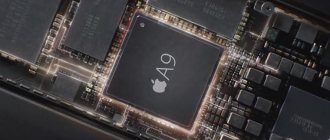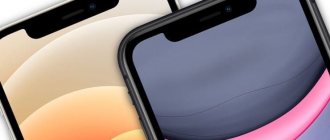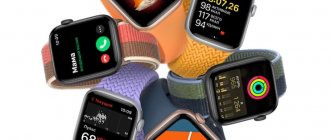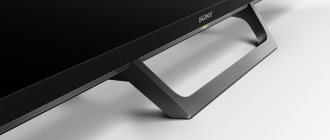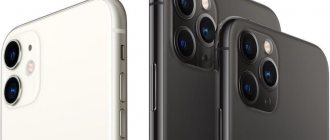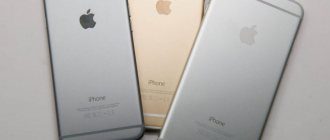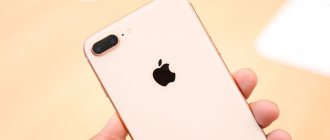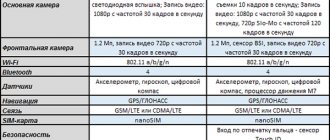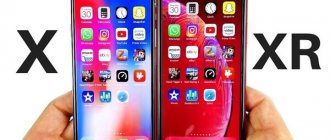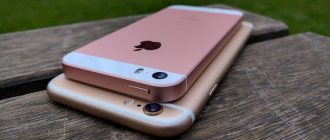Quite a long time has passed since the release of the iPhone 6s / 6s Plus, and the first rumors about the next generation of Apple smartphone have already begun to appear. However, for many fans of Apple products, the question still remains open: is it worth purchasing the 2015 model or choosing the iPhone 7?
The main argument in favor of the second option is the lack of significant difference between the iPhone 6 and iPhone 6s. Nevertheless, there are differences and they are much more significant than it seems at first glance. We will talk about them in this material.
Size and weight
| iPhone 6 | iPhone 6s | |
| Screen diagonal, inches (one inch is 2.54 cm) | 4.7 | 4.7 |
| Length, cm | 13.81 | 13.83 |
| Width, cm | 6.7 | 6.71 |
| Thickness, cm | 0.69 | 0.71 |
| Weight, gram | 129 | 143 |
It is noteworthy that the iPhone 6 weighs less, while the other parameters are virtually no different.
Design and appearance
As for the appearance, if you take both smartphones in your hands, and it doesn’t matter which model it will be - 6 (6s) or 6 Plus (6s Plus), you won’t notice the differences. And why all? Yes, because there are practically no external differences between smartphones.
Practically? Yes, practically, because there are still a couple of differences, and one of them is very significant - the color of the case. If only two colors are available for the iPhone 6 and 6+ (silver and “space gray”), then for the 6s and 6s+ there are four at once, including the same silver, “space gray,” as well as gold and “rose gold.” Accordingly, if you see a golden or pink sixth iPhone, it means that this is a model with the S prefix.
The second difference is extremely insignificant and few people pay attention to it. We are talking about the inscription on the back cover, where there is the letter S in a square.
Display
| iPhone 6 | iPhone 6s | |
| Display name | Retina HD | Retina HD |
| Display Description | 4.7" widescreen Multi-Touch LCD with IPS technology | 4.7" widescreen Multi-Touch LCD with IPS technology |
| Screen resolution, pixels | 1334×750 | 1334×750 |
| Pixels per inch | 326 | 326 |
| Contrast | 1400:1 | 1400:1 |
| Maximum brightness, cd/m² | 500.0 | 500.0 |
What can I say? The models have the same Retina HD display with the same parameters.
3D Touch
Perhaps the main hardware innovation in the iPhone 6s. Apple compares this technology in importance to multi-touch, which is generally true. From now on, the user interface will work not in one, but in two planes at once, in the most literal sense of the word. If previously all gestures on the screen were carried out exclusively on a horizontal surface, now you can press harder and gain access to various functions.
At the same time, a special Taptic Engine drive will provide tactile feedback through vibration. The 3D Touch APIs are open to third-party developers and are being widely implemented in various games and applications.
On the subject : 3D Touch screen in iPhone 6s - how to use it with maximum efficiency.
Camera
Do you like to take pictures with your phone? Then this section will help you better decide on the choice of model.
| iPhone 6 | iPhone 6s | |
| Main camera | ||
| Matrix resolution | 8 MP | 12 MP |
| Digital zoom | 5x digital zoom | 5x digital zoom |
| Front-camera | ||
| Matrix resolution | 1 MP | 5 MP |
If you like to share your selfies on social networks, then choose the iPhone 6s, which has a much better resolution of the front camera. The resolution of the main camera is also much better.
conclusions
For many users, it is important to know whether it is worth changing the “six” to newer versions. It is impossible to give a definite answer.
Since the design from 6 to 6s has not been changed at all, and the improvements “inside” the device are noticeable, it’s worth changing rather. In terms of performance, the phone is definitely better; the improvements are much more noticeable.
There are no major changes from 6 to 6+. The only noticeable difference is the enlargement of the device. But as the case increases, the battery also increases, which gives the iPhone 6 Plus its positive qualities.
iPhone 6 Plus has a larger screen size than the iPhone 6
It is equally important to consider how the phone will be used. As you use it, some functions may turn out to be unnecessary and will slow down the operation of the device, worsening performance.
Don’t also forget that when the screen is enlarged, the device will take a little longer to fully load something.
Also, for some users, the change of gadget was obvious, because... The iPhone 6 case is made of elastic aluminum and the gadget was deformed if stored improperly.
Deformation of the iPhone 6 case
Choose your iPhone wisely, choose the most convenient models and you can avoid many difficulties associated with the operation and settings of the device.
By the way, look at what are the main differences between the iPhone 7 and iPhone 7 Plus and the main differences between the iPhone 8 and iPhone 8 Plus.
VIDEO: iPhone 6S Plus in 2018
Processor, memory size and battery
| iPhone 6 | iPhone 6s | |
| Processor name | Apple A8 | Apple A9 |
| CPU frequency | 1.4 GHz | 1.8 GHz |
| Memory |
|
|
| Wireless charger | No | No |
| Battery life | ||
| During conversation | until 14 o'clock | until 14 o'clock |
| In the Internet | until 10 o'clock | until 10 o'clock |
| When listening to audio | up to 50 hours | up to 50 hours |
Here’s another important difference: the iPhone 6 is inferior to the iPhone 6s in terms of processor speed.
Periphery
The iPhone 6s battery was a disappointment for many users - its capacity not only did not increase, but also decreased from 1810 to 1715 mAh. Software and hardware optimization made it possible to maintain battery life at the same level, but there are no positive changes in this direction.
Few people had serious complaints about the Touch ID fingerprint sensor in the iPhone 6, but work has also been done on it - in the iPhone 6s, fingerprints are scanned even faster and with better quality.
additional characteristics
Take your time to make your choice. Each phone has additional parameters, here are some of them.
| iPhone 6 | iPhone 6s | |
| SIM card | Nano‑SIM | Nano‑SIM |
| Image stabilization | — | — |
| Video recording, frame rate | HD video 1080p at 30 or 60 fps | HD video 1080p at 30 or 60 fps |
| Zoom when recording video | 3x digital zoom | 3x digital zoom |
| Water protection | — | — |
| Geolocation | GPS and GLONASS | GPS, GLONASS, Galileo and QZSS |
| Authentication | Fingerprint ID sensor built into the Home button | Fingerprint ID sensor (2nd generation) built into the Home button |
| Headphone jack | Standard 3.5 mm | Standard 3.5 mm |
Comparison of iPhone 6 and iPhone 6s
At the moment, the newest iPhone is the iPhone 6s, but the iPhone 6 is still on sale, and its cost is noticeably lower. In this regard, many buyers cannot decide whether they should overpay for a new product or whether they can save a little and take last year’s flagship from Apple. In this article, we will make a detailed comparison of the iPhone 6 and iPhone 6s so that you can understand the difference between these smartphones and which one is worth buying.
First, let's briefly compare the characteristics of the iPhone 6 and iPhone 6s that have undergone the most significant changes. Firstly, new colors have appeared in the color scheme of the new iPhone. The iPhone 6 model was available only in silver and dark silver, which was officially called the pretentious name “space gray.” Now two glamorous options have been added to these two colors. It's gold and also a color that Apple calls "rose gold."
iPhone 6s color scheme
Secondly, the iPhone 6s introduced a technology called 3D Touch. This is practically the most important change in the new iPhone. 3D Touch measures the force applied to the screen and, depending on the force applied by the user, various functions of the operating system and programs are called up.
Working with 3D Touch on iPhone 6s
And thirdly, the iPhone 6s received a number of improvements in the hardware platform. It uses a more modern processor, as well as more RAM and internal memory. Both cameras have also changed, they received higher resolution and new features.
Apple A9 processor
You can find out more about the characteristics of these two smartphones from Apple in the comparison table that we have prepared for you (the main changes in the iPhone 6s are highlighted in red).
| iPhone 6 Specifications | iPhone 6s Specifications |
| Available colors: silver, space gray. | Silver, space gray, gold, rose gold. |
| Built-in memory: 16 and 64 gigabytes. | 16, 64 or 128 gigabytes. |
| Screen: IPS screen with a diagonal of 4.7 inches and a resolution of 1334x750 pixels. | IPS screen with a diagonal of 4.7 inches and a resolution of 1334×750 pixels. |
| 3D Touch technology: absent. | Present. |
| Additional screen details: Oleophobic coating, Multi-Touch support, pixel density 326 pixels/inch, brightness 500 candelas/m2, contrast ratio 1400:1, sRGB support. | Oleophobic coating, Multi-Touch support, pixel density 326 pixels/inch, brightness 500 candelas/m2, contrast ratio 1400:1, sRGB support. |
| Weight and dimensions of the device: weight 129 grams, dimensions 138.1 by 67 by 6.9 millimeters. | Weight 143 grams, dimensions 138.3 by 67.1 by 7.1 millimeters. |
| Hardware platform: 64-bit Apple A8 processor with M8 coprocessor. 1 gigabyte of DDR3 RAM. | 64-bit Apple A9 processor with M9 coprocessor. 2 gigabytes of DDR3 RAM. |
Wireless technology support:
|
|
| Touch ID fingerprint sensor: present | Present. |
| iSight camera: 8 megapixel resolution, ƒ/2.2 aperture. Record video at 1080p resolution at 30 or 60 frames per second. | Resolution 12 megapixels, aperture ƒ/2.2. Video recording with 4K resolution and 30 frames per second. Record video in 1080p resolution at 30 or 60 frames per second. |
| Additional information about the camera: five-element lens, light sensor, hybrid autofocus, focusing on an object by touch, protecting the lens with sapphire glass, face recognition, panoramic shooting with a resolution of 43 megapixels, shooting slow-motion video, tracking autofocus when shooting video. | Five-element lens, light sensor, hybrid IR autofocus, touch focusing on an object, sapphire crystal lens protection, face recognition, panoramic shooting with a resolution of 63 megapixels, slow-motion video shooting, tracking autofocus when shooting video. |
| FaceTime camera: 1.2 megapixel resolution, ƒ/2.2 aperture, 720p video recording. | 5 megapixel resolution, ƒ/2.2 aperture, 720p video recording, Retina Flash. |
| Siri assistant: present. | Present. |
| Battery: non-removable lithium-ion battery, providing up to 14 hours of talk time on a 3G network and up to 10 days of standby time. | Non-removable lithium-ion battery provides up to 14 hours of talk time on a 3G network and up to 10 days of standby time. |
| Apple EarPods headphones: present. | Present. |
| Sensors: accelerometer, barometer, ambient light sensor, three-axis gyroscope, distance sensor. | Accelerometer, barometer, ambient light sensor, three-axis gyroscope, distance sensor. |
| SIM card used: Nano-SIM. | Nano-SIM. |
| Connector for connecting to a computer: Lightning. | Lightning. |
We hope that this article comparing iPhone 6 and iPhone 6s will help you decide on the choice and purchase of a new smartphone from Apple.
See also:
- Comparison of iPhone X and iPhone XR: main differences
- Comparison of iPhone X and iPhone XS: main differences
- What's the difference between iPhone 8 and iPhone X?
Wireless capabilities
As for connecting to Wi-Fi, the updated six from the s series picks up wireless communications somewhat worse. But work on cellular networks is noticeably better. 4g is available anywhere in the world.
There is support for LTE Advanced, which means that Internet speeds can reach up to 300 Mbit/s, while on the regular “six” the speed does not exceed 150 Mbit/s. That is, now you can download an hour-long video in half a minute, but on an iPhone 6 this is done in 1-1.5 minutes.
Let's talk about autonomy
Unfortunately, the new model cannot boast of increased battery life, since the new assembly accommodates a smaller battery (1810 mAh versus 1715 mAh). And all because part of the space was taken up by equipment for 3D Touch.
However, don't be discouraged. Due to optimizations, two smartphones work for almost the same amount of time.
Case and assembly features
If you compare the cases externally, you will not notice any differences. And yet they exist. Due to the addition of new hardware to the iPhone 6s, the case has become slightly thicker and longer by 0.2 mm.
As a result, the dimensions of the new device are as follows: 138.3 x 67.1 x 7.1 mm versus 138.1 x 67 x 6.9 mm. However, as we have already said, this is completely invisible.
As for the finishing material, the creators decided to correct their past mistakes and now use not simple aluminum, but the 7000 series. It solved the problem with the instability of the previous iPhone 6 to bending and twisting, since the alloy itself is 60% stronger than its predecessors.
The iPhone 6s also has a new vibration motor called Taptic Engine, which makes the model stand out from others on the market.
It has a faster response, vibration is felt more sharply, and there are many different vibration feedback in terms of speed and duration for different user actions.
As for the assembly itself, it was noticed more than once that the assembly of the iPhone 6 (like the 6+) was not of the best quality. There have been complaints about poor quality installation of the display in the case. It was loose, especially in the lower right part of the phone.
In contrast, the 6s is built perfectly.
What can shorten the life of a battery?
In addition to the wear and tear of the battery due to the intensity of use, its failure is often caused by other factors such as high or low temperatures or their sharp drop. Few people think about it, but the most favorable temperature for iPhone operation should be between 16 and 22 degrees Celsius. If it is very hot (33°C and above), the battery begins to lose its capacity very quickly.
In extreme cold, the same thing happens, and as for frequent temperature fluctuations, they pose the greatest danger to the battery.
It may seem incredible, but outdated software also contributes to rapid battery wear. To prevent this from happening, update your phone's OS regularly and monitor background processes. Here you may need the help of a qualified technician who will diagnose both the “stuffing” of the gadget and whether all of its programs are working correctly.
Remember that the slightest amount of moisture getting inside the case can kill the battery.
Iron
The new models use a new and more powerful Apple A9 processor versus the Apple A8, and the amount of RAM has doubled - from 1 GB to 2 GB. A little by modern standards, would you say? In general, yes, but only if we talk about “dry” numbers. The truth of life is that Apple's mobile device optimization is so good that it doesn't require a ton of RAM, leaving even some of the fastest Android devices behind.
